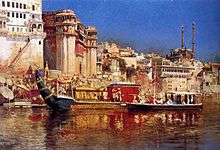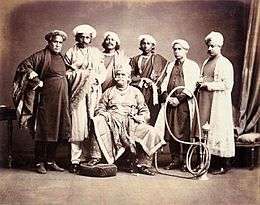Narayan dynasty

Narayan was the ruling Bhumihar Brahmin family of Benares, who ruled from 1000 AD to 1948 AD as Rajas of Benares, were Maharajas of Benares from 1000 AD to 1910 and rulers of the princely state of Benares from 1910 until Indian independence in 1947. Ramnagar Fort and its museum are the repository of the history of the kings of Benares and since the 18th century has been the home of Kashi Naresh.[1] Even today the Kashi Naresh is deeply revered by the people of Benares.[1] He is the religious head and the people of Benares consider him the incarnation of Lord Shiva.[1] He is also the chief cultural patron and an essential part of all religious celebrations.[1]
Zamindars: beginnings to 1770
The family tradition goes back to the year 1000, when a Brahmin ascetic of Utaria, a village near Benares, foretold the succession of his descendants to the dominions then governed by a Hindu raja.[2]
With the decline of Mughal Empire, in the area south of Avadh, in the fertile riverain rice growing areas of Benares, Gorakhpur, Deoria, Ghazipur, Ballia and Bihar and on the fringes of Bengal, it was the 'military' or Bhumihar Brahmins who strengthened their sway.[3] What brought success to these Hindu princelings was the strong clan organisation on which they rested.[3] There were perhaps as many as 100,000 Bhumihar Brahmin clansmen backing the Benares rajas in what later became the districts of Benares, Gorakhpur and Azamgarh.[3] This proved a decisive advantage when the dynasty faced its rival and nominal suzerain, the Nawab of Awadh, in the 1750s and the 1760s.[3] Their support gave the Benares ruler the capacity to mount an exhausting guerrilla war against the Avadh camp using his Bhumihar Brahmin clan levies which forced the Nawab to withdraw his main force.[3]

_-Benares-..jpg)
The Royal House of Benares is of an ancient Gautam clan of Brahmin dating to the year 1000 that originated from Gangapur near Benares. In the late 17th century, one Raja, Mansa Ram of this family entered the service of the Nazim of Benares, Rustam Ali Khan. He grew immensely powerful, fought many wars and rose to become Zamindar of Kaswar in the service of the Nazim, recapturing the kingdom of his ancestors which had been lost to Muslim rulers. Appointed as successor to Rustam Ali Khan by the Nawab of Awadh, Saadat Khan, one year before his death in 1739. Impressed with his ability as an able administrator, Mohammed Shah the mughal emperor appointed him Raja and Nazim for the sarkars of Benares, Jaunpur, Ghazipur and Chunar to be held by his eldest son along with the title of Raja Bahadur of Kaswar.
His eldest son, Rafa'at wa Awal-i-Martabat Raja Sri Balwant Singh Sahib Bahadur, succeeded his father as Raja of Kaswar and Nazim of Benares in 1738. Leading a much more martial life, he built a fort and established a capital at Gangapur, but later moved to Ramnagar. In 1751, he expelled the representative of the Nawab of Awadh in an attempt to carve out a principality at Benares, but had to flee after a fierce fight when the Nawab invaded his domain in March 1752; a settlement was made between the two and he was restored to his titles by the Nawab. Emperor Alamgir II granted him a jagir in Bihar two years later. The first of his house to fight with the East India Company, he joined Shah Alam and Shuja ud-Daula in their 1763 invasion of Bengal. Following the Battle of Buxar in 1764, Emperor Shah Alam transferred Balwant Singh's zamindari to the Company, but the Company refused it along with the Treaty of Benares signed by the Emperor the same year. Instead, the zamindari reverted once again to the Nawab of Awadh in 1765, five years before Balwant Singh's death in 1770.
Rajas of Benares: (1770–1939)

Balwant Singh's elder son, Rafa'at wa Awal-i-Martabat Raja Sri Chait Singh Sahib Bahadur, succeeded to the throne as the next Raja of Benares in 1770. Although the Nawab still wished to hold total suzerainty over the zamindari, the British authorities encouraged him to recognise Chait Singh as zamindar in 1773. Two years later, the Nawab, by now fed up with British interference, transferred the domain to the Company under the direct control of the Governor-General of India, Warren Hastings. Under the new British terms, Chait Singh was empowered to contribute cavalry and maintenance grants for the Company's sepoy battalions. The Raja refused to do this and he began to secretly correspond with enemies of the Company in hopes of forcibly breaking the arrangement. The company discovered his plan, stripped him of his position and placed him under house arrest in August 1781, pending an interview with Hastings. He escaped, killing his unarmed guards and gathered his small forces, appealing for assistance from local rulers, who did nothing. In skirmishes with the Company's forces, Chait Singh's troops were defeated, the rebellion crushed, and the zamindari confiscated and given to his nephew Rafa'at wa Awal-i-Martabat Raja Sri Mahip Narayan Singh Sahib Bahadur on the 14 September 1781. Chait Singh himself took shelter in Awadh, then to Gwalior, where he was granted a jagir for a while until it was later confiscated. He died in Gwalior on 29 March 1810 in obscurity, leaving three sons. The incident greatly tarnished Hastings' image and capability, leading to a failed attempt to impeach him by the British parliament.
Chait Singh's nephew, Raja Sri Mahip Narayan Singh Sahib Bahadur, succeeded his maternal uncle on 14 September 1781 under the terms of the Company, which were that he should serve to dispense justice within his domains and make an annual contribution of 40 lakhs. He continued his family tradition of tussles with Britishers, who in turn proved him incapable of governing, and on 27 October 1794, under a formal agreement the four sarkars, or revenue districts, held by the Raja were transferred to the direct rule of the Company administration, leaving only the family domains under the rule of the Raja; in return Mahip Narayan Singh received 1 lakh per year in compensation and any surplus revenue of the sarkars. Mahipat Narayan Singh died barely a year lateer and was succeeded by his eldest son, Rafa'at wa Awal-i-Martabat Raja Sri Udit Narayan Singh Sahib Bahadur.
The eldest surviving son of Mahip Narayan Singh, Udit Narayan Singh Sahib Bahadur (1770 – 4 April 1835, r. 12 September 1795 – 4 April 1835) was even more averse to British dominion and had regular confrontations with the company, who in turn proved him more incapable as an administrator than his father had been. In 1828, he petitioned the company to annul the 1794 agreement under which the family had lost the sarkars, and to press for their return to family control. However, the company instead ordered a detailed enquiry into Udit Narayan Singh's personal affairs and his governance of the family domains. Finding them to be grossly mismanaged, the company confiscated the last remaining lands of the Rajas and placed them under their own control. It would be over five decades before the domains would be restored to the family. Udit Narayan Singh died on 4 April 1835, aged 65, and was succeeded by his nephew, Raja Sri Ishwari Prasad Narayan Singh Sahib Bahadur.

His Highness Maharaja Bahadur Sri Sir Ishwari Prasad Narayan Singh, GCSI (1822-13 June 1889) succeeded his uncle upon the latter's death in 1835, becoming the first of his line to be granted the title of Maharaja. Ascending the throne at the age of 13, during the Indian Rebellion of 1857 he remained neutral to revolt. As a reward, he was promoted to the rank of Maharaja Bahadur in 1859. In 1867, he was granted a personal 13-gun salute; a decade later he was knighted with the GCSI, becoming Sir Ishwari. He eventually became a member of the Viceroy's Legislative Council and in the crowning achievement of his reign, restored all the family lands that had been lost to them for over a century. Given the title of His Highness in 1889,H H Maharaja Sir Ishwari Prasad Narayan Singh died several months later, aged 67 and was succeeded by his nephew, Prabhu Narayan Singh Sahib Bahadur.
Prabhu Narayan Singh would reign for 42 years as Maharaja; in 1891, he was knighted with the KCIE, later becoming an honorary colonel in the Indian Army. In 1911, he became the first Maharaja of the newly created princely state of Benares, including the parganas of Bhadohi and Keramnagar, Chakia and Ramnagar, together with certain limited rights within the City of Benares. He donated 1,300 acres of land to establish famous Banaras Hindu University. Given Benares's close ties to Nepal, it was not surprising when Sir Prabhu Narayan married a daughter of Jang Bahadur, the first modern Nepali prime minister, as his first wife. He later married a distant relation of the family, a sister of Babu Jagdep Narayan Singh. Dying in 1931, aged 75,Maharaja Sir Prabhu Narayan was succeeded by his only son, Captain Sir Aditya Narayan Singh. Aditya Narayan Singh would reign for only seven and a half years before dying in 1939, aged 64. Having had no children, Maharaja Aditya Narayan had adopted a distant cousin to succeed him.
Last Maharaja 1939-1947-1971-2000
Maharaja Vibhuti Narayan Singh, as he was to be known was born on 5 November 1927, the great-nephew of the second wife of Maharaja Sir Prabhu Narayan Singh. In 1934, when he was six years old, he was adopted by his distant cousin, Maharaja Sir Aditya Narayan Singh of Benares, becoming heir apparent and receiving a new name,Maharaj Kumar Vibhuti Narayan Singh. Five years later, the old Maharaja died, and Maharaja Vibhuti Narayan Singh became Maharaja under a regency until he succeeded to the throne in his own right as Maharaja on 11 July 1947, a month before India's independence. On 15 August,Maharaja Vibuti Narayan signed the Instrument of Accession to India. On 15 October 1947, he merged Benares into the new Indian state of Uttar Pradesh. This marked the end of Maharaja Vibhuti Narayan Singh's short reign, although he would maintain his titles for many more years.
A deeply religious believer in, and scholar of, the Vedas and Puranas, Maharaja Vibhuti Narayan Singh strictly adhered to orthodox Hindu customs. Despite the decision of the Indira Gandhi government to abolish the titles of the Indian monarchs on 28 December 1971, he remained deeply respected for the remainder of his life. A distinguished scholar of Sanskrit, Puranas and the Vedas, he presided over a number of scholastic, religious and charitable institutions, including a term from 1992 until his death as Chancellor of Benares Hindu University, and took part in public religious ceremonies in the City of Benares. At his death on Christmas Day, 2000, aged 73, he had 4 children, 3 daughters and a son; Maharaj Kumari Shri Vishnu Priya, Maharaj Kumari Shri Har Priya, Maharaj Kumari Shri Krishna Priya and the youngest being Maharaj Anant Narayan Singh who succeeded him. Maharaj Anant Narayan Singh has two sons: Kunwar Aniruddh Narayan Singh and Praddyumna Narayan Singh.
See also
References
- 1 2 3 4 Mitra, Swati (2002). Good Earth Varanasi city guide. Eicher Goodearth Limited. p. 216. ISBN 978-81-87780-04-5.
- ↑ Lethbridge, Sir Roper (2005). The golden book of India: a genealogical and biographical dictionary of the ruling princes, chiefs, nobles, and other personages, titled or decorated of the Indian empire. Aakar Books. p. 584. ISBN 978-81-87879-54-1.
- 1 2 3 4 5 Bayly, Christopher Alan (1983). Rulers, Townsmen, and Bazaars: North Indian Society in the Age of British Expansion, 1770–1870. Cambridge University Press. p. 489 (at p 18). ISBN 978-0-521-31054-3.
Further reading
- Queensland University.au: Genealogy of Benaras (Princely State)
- Royalark.net: Detailed history of Benaras